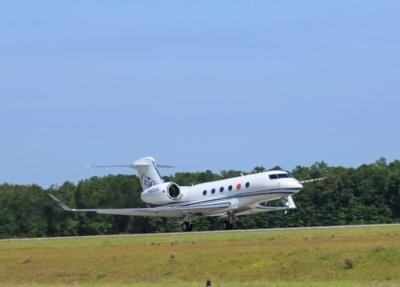Mon, May 18, 2015
Two-Hour And 16-Minute Flight Conducted For Evaluation Of Multiple Systems
There's another new business jet starting its flight test program. The all-new Gulfstream G500 successfully completed its first flight Monday.

The G500 took off at 10:39 a.m. May 18 from Savannah-Hilton Head International Airport, with Gulfstream experimental test pilots Scott Martin and Kevin Claffy at the controls. Flight Test engineer Bill Osborne provided on-board support.
The aircraft climbed to an initial altitude of 10,500 feet and reached a maximum altitude of 15,000 ft. During the 2-hour-and-16-minute flight, the crew exercised all primary flight control systems; evaluated handling qualities in takeoff and landing configurations; performed a simulated approach and go-around; and checked all systems using the Symmetry flight deck touchscreen controllers. The aircraft achieved a maximum air speed of 194 knots. It landed back in Savannah at 12:55 p.m. local time.
“The successful first flight of N500GA represents the tremendous investments we have made in the G500 program,” said Dan Nale, senior vice president, Programs, Engineering and Test, Gulfstream. “We have achieved this milestone thanks to Gulfstream’s world-class research and development teams and our commitment to setting new standards for business aviation.”
Years before this first flight, Gulfstream established four labs dedicated to the G500 program:
- A Conceptual Advanced Simulation Environment to develop fly-by-wire control laws and perform human factors evaluations
- A systems integration bench to integrate the avionics and aircraft systems with the aircraft’s Data Concentration Network
- A full flight deck integration test facility to evaluate major avionic and aircraft systems and software
- The ITF also includes an outfitted cabin to test the galley, the Gulfstream Cabin Management System and other interior elements
- And an iron bird — a spatially correct, dimensionally accurate structure, including the flight deck, used to rigorously evaluate the fly-by-wire flight controls, hydraulics, electrical systems and landing gear
- Before today’s flight, Gulfstream completed more than 34,000 hours of testing in the G500 labs on the ground before taking to the skies.
The G500 flight-test program consists of five aircraft, including a fully outfitted production aircraft that will allow the company to test all the interior elements and complete integration of the aircraft systems with the passenger experience.
The G500 is expected to receive type certification from the U.S. Federal Aviation Administration and European Aviation Safety Agency in 2017. It is slated to enter service in 2018.
(Image provided by Gulfstream)
More News
Charted Visual Flight Procedure Approach An approach conducted while operating on an instrument flight rules (IFR) flight plan which authorizes the pilot of an aircraft to proceed >[...]
“When l became the Secretary of Defense, I committed to rebuild our military to match threats to capabilities. Drones are the biggest battlefield innovation in a generation, >[...]
Aero Linx: Stearman Restorers Association Welcome to the Stearman Restorers Association. The Stearman Restorers Association is an independent “Not for Profit” 501C-3 Co>[...]
Airplane Exhibited A Partial Loss Of Engine Power When It Was About Halfway Down The Runway Analysis: The pilot of the experimental amateur-built airplane was departing from his pr>[...]
The Flight Path Was Consistent With Low-Altitude Maneuvering On June 18, 2025, about 0922 mountain standard time, a Cessna A150L airplane, N6436F, was substantially damaged when it>[...]
 ANN's Daily Aero-Term (07.15.25): Charted Visual Flight Procedure Approach
ANN's Daily Aero-Term (07.15.25): Charted Visual Flight Procedure Approach Aero-News: Quote of the Day (07.15.25)
Aero-News: Quote of the Day (07.15.25) ANN's Daily Aero-Linx (07.15.25)
ANN's Daily Aero-Linx (07.15.25) NTSB Final Report: Kjelsrud Gary Kitfox
NTSB Final Report: Kjelsrud Gary Kitfox NTSB Prelim: Cessna A150L
NTSB Prelim: Cessna A150L



